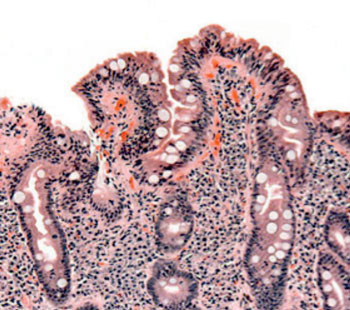Reduced Elafin Levels Associated with Celiac Disease Bowel Inflammation
By LabMedica International staff writers
Posted on 22 Apr 2014
Levels of the enzyme elafin, an endogenous serine protease inhibitor, were lower in the small intestinal epithelium of patients with active celiac disease (CD) as compared to similar tissue from control patients.Posted on 22 Apr 2014
Celiac disease is an immune disorder that occurs in susceptible individuals when foods that contain gluten and its derivative, the highly immunogenic gliadin peptide, trigger an immune response that leads to destruction of the intestinal lining, abdominal pain, changes in bowel habits, malnutrition and other symptoms that include anemia and neurological problems.

Image: Biopsy of small bowel showing celiac disease manifested by blunting of villi, crypt hyperplasia, and lymphocyte infiltration of crypts (Photo courtesy of Wikimedia Commons).
Investigators at McMaster University (Hamilton, ON, Canada) used immunofluorescence techniques to examine the role of elafin in CD using tissues taken from human small intestines. The degree of deamidation of the 33-mer gliadin peptide was analyzed by liquid chromatography-mass spectrometry. To study the effects of elafin on a mouse model of celiac disease, the protein was delivered to the intestine of gluten-sensitive mice using a recombinant Lactococcus lactis vector.
Results published in the April 8, 2014, online edition of the American Journal of Gastroenterology revealed that elafin expression in the small intestinal epithelium was lower in patients with active CD compared with control patients. In vitro, elafin significantly slowed the kinetics of the deamidation of the 33-mer peptide to its more immunogenic form. Treatment of gluten-sensitive mice with elafin delivered by the L. lactis vector normalized inflammation and improved permeability.
Maintaining a gluten-free diet is far from simple, as gluten is found not only in foods but as low cost filler in the cosmetic and pharmaceutical industries as well.
“People who have to strictly avoid gluten for life often find this very difficult due to these hidden sources,” said senior author Dr. Elena Verdu, associate professor of medicine at McMaster University. “There is a great need for a therapy that will protect patients with celiac disease from these accidental contaminations. The possibility of elafin administration or replacement as a new adjuvant therapy to the gluten free diet would add flexibility to a restrictive lifelong diet, and increase patients’ quality of life and potentially accelerate the healing of celiac lesions.”
Related Links:
McMaster University













